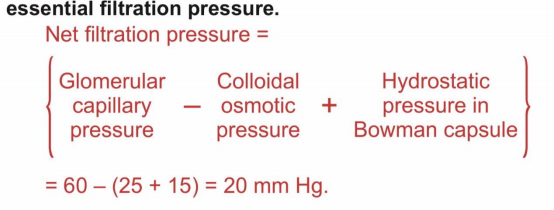2.Glomerular filtration rate (GFR)
3.Pressures determining filtration rate
Glomerular filtration refers to the process of ultrafiltration of plasma from the glomerular capillaries to the Bowman capsule. Filtration is a process in which blood pressure pushes plasma and dissolved material out of the capillaries. In glomerular filtration, blood pressure pushes plasma, dissolved substances and small proteins out of the glomeruli and into the Bowman’s capsule.
Glomerular filtration occurs from the glomerulus to Bowman’s capsule. The pathway for ultrafiltration of plasma from the glomerulus to the Bowman space consists of the fenestrated capillary endothelium, the capillary basement membrane, and the visceral epithelial cell layer (podocytes) of the Bowman capsule. High blood pressure (60 mmHg) in the glomerulus pushes plasma, dissolved materials, and small proteins out of the blood and into the Bowman capsule. The fluid at this moment is called (filtrate).
Filtration is primarily determined by the molecular size and shape of the filtered solute and, to a lesser degree by its charge, the blood cells and large proteins remain in the blood.
The glomerular filtration rate (GFR) is defined as the total amount of filtrate produced in all nephrons of both kidneys in the given unit of time. The normal GFR is 125 mL/minute or approximately 180 L/day. Increased blood flow to the kidneys increases GFR and reduced blood flow reduces GFR.
The 3 pressures, which determine the GFR are:
Glomerular filtration rate (GFR) is determined by either favoring or opposing the filtration by these pressures.
Glomerular capillary pressure is the blood pressure in the glomerular capillaries. It is roughly 60 mm Hg and ranges between 45- and 70-mm Hg. Glomerular capillary pressure is the body's highest capillary pressure. This pressure favors glomerular filtration
This is the pressure exerted by the plasma proteins in the glomeruli. The Plasma proteins are not filtered by the glomerular capillaries and remain in the glomerular capillaries. These proteins produce a colloidal osmotic pressure of about 25 mm Hg. This pressure opposes glomerular filtration.
This is the pressure exerted by the filtrate in the Bowman capsule. It is often referred to as capsular pressure. It's around 15 mm Hg. It also opposes glomerular filtration.
Net filtration pressure is the balance between the pressure that supports filtration and the pressure that opposes filtration. It is otherwise referred to as effective filtration pressure or essential filtration pressure.
Net filtration pressure is about 20 mm Hg and, it varies between 15- and 20-mm Hg.

The determination of net filtration pressure is based on the Starling hypothesis. The Starling hypothesis indicates that net filtration through the capillary membrane is proportional to the difference in hydrostatic pressure across the membrane minus the difference in oncotic pressure. Hydrostatic pressure inside the glomerular capillaries is the glomerular capillary pressure.
The coefficient of filtration is GFR in terms of net filtration pressure. This is the GFR per mm Hg of net filtration pressure. E.g., when GFR is 125 mL / min and net filtration pressure are 20 mm Hg.

The factors which regulate glomerular filtration rate (GFR) include:
1.GUYTON AND HALL, Textbook of Medical Physiology, 12th edition, Jackson, Mississippi, University of Mississippi Medical Center, [2011]
2.K SEMBULINGAM AND PREMA SEMBULINGAM, Essentials of Medical Physiology, Sixth Edition, New Delhi, Panama City, London, Dhaka, Kathmandu, JAYPEE BROTHERS MEDICAL PUBLISHERS (P) LTD, [2012]
3.INDU KHURANA AND ARUSHI KHURANA, Textbook of Medical Physiology, 2nd Edition, India, Elsevier India, [December 1, 2015]
4.JOHN FEEHALLY, JÜRGEN FLOEGE, MARCELLO TONELLI, RICHARD J. JOHNSON, Comprehensive Clinical Nephrology, Sixth Edition, Edinburgh, London, New York, Oxford, Philadelphia, StLouis, Sydney, Elsevier, [September 11, 2018]
5.VALERIE C. SCANLON, TINA SANDERS, Essentials of Anatomy and Physiology, fifth edition, New York, F. A. Davis Company, [January 1, 2006]
6.KIM E. BARRETT, SUSAN M. BARMAN, HEDDWEN L. BROOKS, JASON YUAN, Ganong's Review of Medical Physiology, 26th edition, New York, Chicago, San Francisco, Athens London, Madrid, Mexico City, Milan, New Delhi, Singapore, Sydney, Toronto, Mc Graw Hill Education, [January 29, 2019]
7.ANNE WAUGH, ALLISON GRANT, Ross and Wilson ANATOMY and PHYSIOLOGY in Health and Illness, 11th edition, Edinburgh, London, New York, Oxford, Philadelphia, St Louis Sydney, Toronto, Churchill Livingstone, [September 7, 2010]
Urine formation happens in three major steps, The first step is glomerular filtration, which is followed by the tubular reabsorption and the tubular secretion. Click here to read about these steps in detail.

The 5 Functions of the kidneys are: Play role in homeostasis, Regulate Erythrocyte Production, secrete many hormonal substances, Regulate blood pressure and …

The urethra is a muscular canal that extends from the neck of the bladder to the exterior of body. Read more about the anatomy of urethra in this article.

Chronic kidney disease (CKD) is a disease in which irreversible damage to the kidneys leads to a reduction in kidney function. CKD has 5 stages and many complications.

Learn about medical uses, safety profile, mechanisms and interactions of statins.

Comprehensive guide on Ozempic (semaglutide), including its uses, dosage, side effects, warnings, and interactions.
.png)